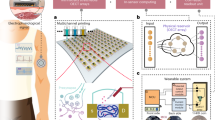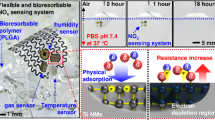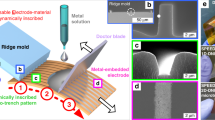Abstract
The development of a robust method for integrating high-performance semiconductors on flexible plastics could enable exciting avenues in fundamental research and novel applications. One area of vital relevance is chemical and biological sensing, which if implemented on biocompatible substrates, could yield breakthroughs in implantable or wearable monitoring systems. Semiconducting nanowires (and nanotubes) are particularly sensitive chemical sensors because of their high surface-to-volume ratios. Here, we present a scalable and parallel process for transferring hundreds of pre-aligned silicon nanowires onto plastic to yield highly ordered films for low-power sensor chips. The nanowires are excellent field-effect transistors, and, as sensors, exhibit parts-per-billion sensitivity to NO2, a hazardous pollutant. We also use SiO2 surface chemistries to construct a ‘nano-electronic nose’ library, which can distinguish acetone and hexane vapours via distributed responses. The excellent sensing performance coupled with bendable plastic could open up opportunities in portable, wearable or even implantable sensors.
This is a preview of subscription content, access via your institution
Access options
Subscription info for Japanese customers
We have a dedicated website for our Japanese customers. Please go to natureasia.com to subscribe to this journal.
Buy this article
- Purchase on SpringerLink
- Instant access to full article PDF
Prices may be subject to local taxes which are calculated during checkout





Similar content being viewed by others
References
Service, R. F. Inorganic electronics begin to flex their muscle. Science 312, 1593–1594 (2006).
Reuss, R. H. et al. Macroelectronics: Perspectives on technology and applications. Proc. IEEE 93, 1239–1256 (2005).
Xu, J. M. Plastic electronics and future trends in microelectronics. Synth. Met. 115, 1–3 (2000).
Uchikoga, S. Low-temperature polycrystalline silicon thin-film transistor technologies for system-on-glass displays. Mater. Res. Soc. Bull. 27, 881–885 (2002).
Gosain, D. P., Noguchi, T. & Usui, S. High mobility thin film transistors fabricated on a plastic substrate at a processing temperature of 110∘C. Jpn J. Appl. Phys. 2 39, L179–L181 (2000).
Lemmi, F. et al. High-performance TFTs fabricated on plastic substrates. IEEE Electron Device Lett. 25, 486–488 (2004).
Gosain, D. P. Excimer laser crystallized poly-Si TFTs on plastic substrates. Proc. SPIE 4426, 394–400 (2002).
Boyce, J. B. & Mei, P. in Technology and Applications of Amorphous Silicon (ed. Street, R. A.) 94–146 (Springer, New York, 2000).
Duan, X. et al. High-performance thin-film transistors using semiconductor nanowires and nanoribbons. Nature 425, 274–278 (2003).
Friedman, R. S., McAlpine, M. C., Ricketts, D. S., Ham, D. & Lieber, C. M. Nanotechnology: High-speed integrated nanowire circuits. Nature 434, 1085 (2005).
McAlpine, M. C., Friedman, R. S. & Lieber, C. M. High-performance nanowire electronics and photonics and nanoscale patterning on flexible plastic substrates. Proc. IEEE 93, 1357–1363 (2005).
Snyder, E. J., Chideme, J. & Craig, G. S. W. Fluidic self-assembly of semiconductor devices: A promising new method of mass-producing flexible circuitry. Jpn J. Appl. Phys. 1 41, 4366–4369 (2002).
Stauth, S. A. & Parviz, B. A. Self-assembled single-crystal silicon circuits on plastic. Proc. Natl Acad. Sci. USA 103, 13922–13927 (2006).
Whang, D., Jin, S., Wu, Y. & Lieber, C. M. Large-scale hierarchical organization of nanowire arrays for integrated nanosystems. Nano Lett. 3, 1255–1259 (2003).
Tao, A. et al. Langmuir-Blodgett silver nanowire monolayers for molecular sensing using surface-enhanced Raman spectroscopy. Nano Lett. 3, 1229–1233 (2003).
Ahn, J.-H. et al. Heterogeneous three-dimensional electronics by use of printed semiconductor nanomaterials. Science 314, 1754–1757 (2006).
Shimoda, T., Inoue, S. & Utsunomiya, S. Polysilicon TFT on plastics. Proc. SPIE 4295, 52–59 (2001).
Sun, Y., Kim, S., Adesida, I. & Rogers, J. A. Bendable GaAs metal-semiconductor field-effect transistors formed with printed GaAs wire arrays on plastic substrates. Appl. Phys. Lett. 87, 083501 (2005).
Menard, E., Nuzzo, R. G. & Rogers, J. A. Bendable single crystal silicon thin film transistors formed by printing on plastic substrates. Appl. Phys. Lett. 86, 093507 (2005).
Lee, K. J. et al. A printable form of single-crystalline gallium nitride for flexible optoelectronic systems. Small 1, 1164–1168 (2005).
Sun, Y. & Rogers, J. A. Fabricating semiconductor nano/microwires and transfer printing ordered arrays of them onto plastic substrates. Nano Lett. 4, 1953–1959 (2004).
Melosh, N. A. et al. Ultrahigh-density nanowire lattices and circuits. Science 300, 112–115 (2003).
Wang, D., Sheriff, B. A. & Heath, J. R. Silicon p-FETs from ultrahigh density nanowire arrays. Nano Lett. 6, 1096–1100 (2006).
Sze, S. M. Semiconductor Devices: Physics and Technology (Wiley, New York, 1985).
Jung, G.-Y. et al. Circuit fabrication at 17 nm half-pitch by nanoimprint lithography. Nano Lett. 6, 351–354 (2006).
Bunimovich, Y. L. et al. Quantitative real-time measurements of DNA hybridization with alkylated nonoxidized silicon nanowires in electrolyte solution. J. Am. Chem. Soc. 128, 16323–16331 (2006).
Cui, Y., Zhong, Z., Wang, D., Wang, W. U. & Lieber, C. M. High performance silicon nanowire field effect transistors. Nano Lett. 3, 149–152 (2003).
Wolf, S. & Tauber, R. N. Silicon Processing for the VLSI Era (Lattice Press, Sunset Beach, 2000).
Javey, A. et al. Carbon nanotube field-effect transistors with integrated Ohmic contacts and high-k gate dielectrics. Nano Lett. 4, 447–450 (2004).
Xiang, J. et al. Ge/Si nanowire heterostructures as high-performance field-effect transistors. Nature 441, 489–493 (2006).
Urban, G. et al. Miniaturized multi-enzyme biosensors integrated with pH sensors on flexible polymer carriers for in vivo applications. Biosens. Bioelectron. 7, 733–739 (1992).
Mastrototaro, J. J. et al. An electroenzymic glucose sensor fabricated on a flexible substrate. Sensors Actuators B 5, 139–144 (1991).
Cattanach, K., Kulkarni, R. D., Kozlov, M. & Manohar, S. K. Flexible carbon nanotube sensors for nerve agent simulants. Nanotechnology 17, 4123–4128 (2006).
Valentini, L. et al. Sensors for sub-ppm NO2 gas detection based on carbon nanotube thin films. Appl. Phys. Lett. 82, 961–963 (2003).
Qi, P. et al. Toward large arrays of multiplex functionalized carbon nanotube sensors for highly sensitive and selective molecular detection. Nano Lett. 3, 347–351 (2003).
Zhang, D. et al. Detection of NO2 down to ppb levels using individual and multiple In2O3 nanowire devices. Nano Lett. 4, 1919–1924 (2004).
Cui, Y., Wei, Q., Park, H. & Lieber, C. M. Nanowire nanosensors for highly sensitive and selective detection of biological and chemical species. Science 293, 1289–1292 (2001).
Li, C. et al. Complementary detection of prostate-specific antigen using In2O3 nanowires and carbon nanotubes. J. Am. Chem. Soc. 127, 12484–12485 (2005).
Schwartz, M. P., Alvarez, S. D. & Sailor, M. J. Porous SiO2 interferometric biosensor for quantitative determination of protein interactions: Binding of protein A to immunoglobulins derived from different species. Anal. Chem. 79, 327–334 (2007).
Star, A. et al. Label-free detection of DNA hybridization using carbon nanotube network field-effect transistors. Proc. Natl Acad. Sci. USA 103, 921–926 (2006).
Belanger, K., Gent, J. F., Triche, E. W., Bracken, M. B. & Leaderer, B. P. Association of indoor nitrogen dioxide exposure with respiratory symptoms in children with asthma. Am. J. Resp. Crit. Care Med. 173, 297–303 (2006).
Steffes, H., Imawan, C., Solzbacher, F. & Obermeier, E. Enhancement of NO2 sensing properties of In2O3-based thin films using an Au or Ti surface modification. Sensors Actuators B 78, 106–112 (2001).
Shieh, J., Feng, H. M., Hon, M. H. & Juang, H. Y. WO3 and W–Ti–O thin-film gas sensors prepared by sol-gel dip-coating. Sensors Actuators B 86, 75–80 (2002).
Beckman, R., Johnston-Halperin, E., Luo, Y., Green, J. E. & Heath, J. R. Bridging dimensions: Demultiplexing ultrahigh-density nanowire circuits. Science 310, 465–468 (2005).
Howarter, J. A. & Youngblood, J. P. Optimization of silica silanization by 3-aminopropyltriethoxysilane. Langmuir 22, 11142–11147 (2006).
Sysoev, V. V., Button, B. K., Wepsiec, K., Dmitriev, S. & Kolmakov, A. Toward the nanoscopic “electronic nose”: Hydrogen vs carbon monoxide discrimination with an array of individual metal oxide nano- and mesowire sensors. Nano Lett. 6, 1584–1588 (2006).
Staii, C., Johnson, A. T. Jr, Chen, M. & Gelperin, A. DNA-decorated carbon nanotubes for chemical sensing. Nano Lett. 5, 1774–1778 (2005).
Freund, M. S. & Lewis, N. S. A chemically diverse conducting polymer-based electronic nose. Proc. Natl Acad. Sci. USA 92, 2652–2656 (1995).
Muller, R. in Sensors: A Comprehensive Survey. Vol. 1, Fundamentals and General Aspects (eds Gopel, W., Hesse, J., Zemel, J. N., Gandke, T. & Ko, W. H.) 313–330 (VCH, Weinheim, 1989).
Turner, A. P. F. & Magan, N. Innovation: Electronic noses and disease diagnostics. Nature Rev. Microbiol. 2, 161–166 (2004).
Acknowledgements
We thank W. Dichtel, A. Boukai and Y. Bunimovich for useful discussions. M.C.M. thanks the Intelligence Community Postdoctoral Research Fellowship Program for financial support. J.R.H. acknowledges primary support of this work via a contract from the MITRE Corporation, and support from the National Cancer Institute (#5U54 CA119347).
Author information
Authors and Affiliations
Contributions
M.C.M. and J.R.H. conceived the experiments, M.C.M. carried out the experiments and M.C.M., H.A. and D.W. designed the experiments.
Corresponding author
Ethics declarations
Competing interests
The authors declare no competing financial interests.
Rights and permissions
About this article
Cite this article
McAlpine, M., Ahmad, H., Wang, D. et al. Highly ordered nanowire arrays on plastic substrates for ultrasensitive flexible chemical sensors. Nature Mater 6, 379–384 (2007). https://doi.org/10.1038/nmat1891
Received:
Accepted:
Published:
Issue Date:
DOI: https://doi.org/10.1038/nmat1891
This article is cited by
-
Forming free bipolar resistive switching in SiOx-based flexible MIM devices
Bulletin of Materials Science (2024)
-
Joint angle measurement by stretchable strain sensor
Journal of Ambient Intelligence and Humanized Computing (2023)
-
Recent Progress on Flexible Room-Temperature Gas Sensors Based on Metal Oxide Semiconductor
Nano-Micro Letters (2022)
-
Long-term cyclic use of a sample collector for toilet-based urine analysis
Scientific Reports (2021)
-
Photosensors-based on cadmium sulfide (CdS) nanostructures: a review
Journal of the Korean Ceramic Society (2021)



